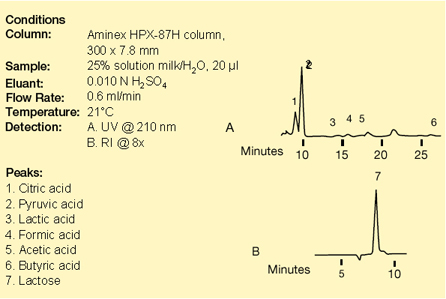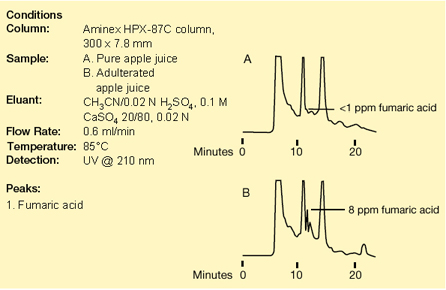An important application of chromatography is in food production. Chromatography can be used at various stages from determining the quality of food to detecting additives. In this section, we describe some of these applications.
Related Topics: Antibody Purification, Histidine-Tagged Recombinant Protein Purification and On-Column Refolding, Disease Diagnosis Using Chromatography, and Analysis of Wine Fermentation Using Chromatography.
Page Contents
Vitamin C, which is naturally present in many food products, is also added to vitamin-fortified foods and drinks as a supplement. Because vitamin C is the nutrient most negatively affected by food processing, the depletion of vitamin C in finished food products can be used as an indicator of the depletion of other important nutrients; thus, the food industry monitors vitamin C content throughout food processing. An Aminex® column can be used to provide a rapid and precise method for monitoring vitamin C contents in food and beverages. This analysis can be performed in less than three minutes using the Bio-Rad fast acid analysis column with electrochemical detection. This selective detection allows for the rapid analysis of vitamin C even in complex samples. This column has been successfully used to quantitatively determine vitamin C in fresh and frozen fruits and vegetables, fresh drinks and juices, and powdered drinks.
Food spoilage can result in health problems ranging from gastrointestinal upset to, in the worst cases, death. Quantitative determinations of organic acids in food products can provide important information in flavor studies, nutritional assessments, and spoilage detection. Since milk is a common food in the Western diet, it is important to monitor milk’s quality and the presence of spoilage indicators. In this application, the Aminex HPX-87H column is used to quantify pyruvic acid in milk (Figure 1A). Pyruvic acid is produced by lactic acid bacteria and is a measure of psychrotrophic bacteria spoilage. Although these bacteria are not pathogenic, their metabolites negatively affect milk flavor and continue to grow during refrigeration. At the same time, the method can be used to measure lactose, a sweetness indicator (Figure 1B), and to obtain a total organic acid profile of the milk. The Aminex HPX-87H column is much faster than bacterial plating techniques, which may require several days. These time savings are critical in the food industry, as an outbreak of bacterial spoilage must be identified as early as possible to minimize potential health problems.

Fig. 1. Analysis of organic acids and lactose in milk on the Aminex HPX-87H column.
Organic acids are often added to food products to enhance or modify their flavors or to make the products more palatable and more acceptable to consumers. One such example is the addition of malic acid and sugar to apple juice that has been diluted with water to extend volume. This restores the sugar and acid content and satisfies consumer taste. Malic acid naturally occurs in apple juice and is the predominant acid. Therefore, it is sometimes difficult to detect adulteration because the level of natural malic acid varies greatly. Monitoring malic acid content alone is not a reliable indicator of adulteration. However, because fumaric acid is an inherent contaminant of all commercially available malic acid, the level of fumaric acid in a sample of juice is an excellent indication of the presence of synthetic malic acid. Because fumaric acid is present at levels less than 1 ppm in pure apple juice, finding fumaric acid levels greater than 3 ppm is a reason to suspect the addition of malic acid. The Aminex
HPX-87C column provides a means for the fast and accurate analysis of fumaric acid levels in apple juice (see Figure 2).

Fig. 2. Analysis of fumaric acid in apple juice on the Aminex HPX-87C column.
